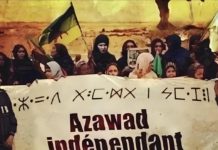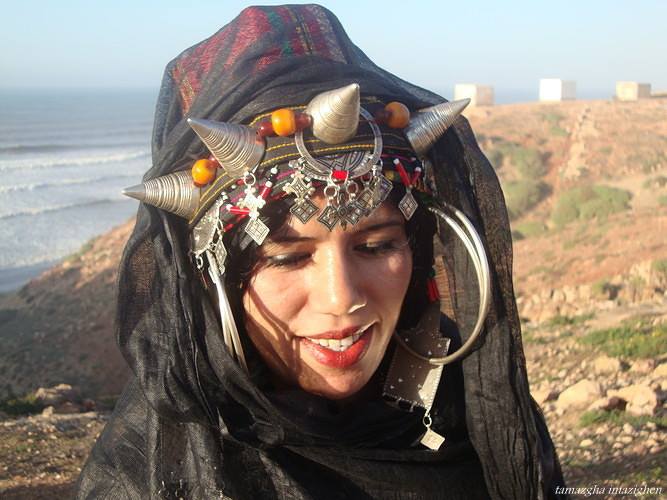Racism has always been both an instrument of discrimination and a tool of exploitation against minorities throughout history. For example, In “Jahili” society, pre-islamic Arabia, people were segregated for their sex and girls were buried alive. And to protect Individuals and groups, Islam came to ban all forms of racism. According to a Hadith, a saying of the prophet Muhammad PBUH, there is no difference between a black and a white, nor between an Arab and a non-Arab except in the level of one’s righteousness.

So, it is crystal clear that Islam does not support any segregation between people. Unfortunately, this is not the case in all Muslim societies. For example, in Morocco Imazighen; Berbers; are still suffering from language racism.
Though Imazighen; Aborigines of Morocco and other states in North Africa; are known for their open mindedness and serenity, they always objected culture abuse. And as they do not have any complexities, Imazighen are predisposed to lead a harmonious life in total coexistence with people of different faiths, races, and languages as far as their identity is respected. Unfortunately, in Morocco Arabs are not yet ready to accept the difference. Their belief in unilateral state and disdain to amazigh language and culture dates back to the Islamic invasion of Morocco.
This unilateralism is reflected through the Arab pedigree scholars who proclaim that the origins of Imazighen go back to Yamen; as the case is with all the imperialists. For example, French politicians also did the same thing while preparing to occupy Morocco and propagated that Imazighen are of European origins. Fortunately, any person armed with a modicum of history rudiments, or even a minimum of critical thinking would know that North Africa ,as many other places of the globe, knew immigration from and to different other places. Therefore, the claim that Berber’s origin is Arab, from Yemen, is self-contradictory.
As far as the disdainfulness is concerned, Mosa Bnu Nosayer; The head of Arab invaders to Morocco; preferred to stay with his army in Tunisia and considered Imazighen as laboratory mice to invade spain. He delegated Tarik Bnu Zyad; an Amazigh leader; to break into Spain and report to him about strengths and weaknesses of the Spanish army thus he can act accordingly. All Moroccan students learned at schools that Tarik Bnu Zyad is a Muslim amazigh leader who “opened” Iberian Peninsula. Almost all Moroccan students were taught Tarik’s harangue to his Army. The question that strongly poses itself is why were not we taught about his end? The simple answer is that instead of being glorified for what he did to Arab caliphate, he was convicted of stealing the booties and was tortured to death. Another form of Hatred and sadism toward Imazighen is reflected in Bnu Nosayer’s deeds who tears the ears of all Berber leaders he defeated as a reminder for them to never try to conflict Arabs.
Arriving to the modern history of Morocco, the late king, Mohamed the fifth, signed on May 30, 1930 a decree that “organizes justice in tribes of Amazigh conventions”. The protocol of Morocco in that time to the present is that all decrees signed by the king are named “Royal Dahir”, except the aforementioned. The Arab activists of national movement propagated that the decree aims to separate Arabs from Amazigh people and to evangelize Imazighen as a procedure among others for this separation. And in their attempt to attach all what is colonial to Imazighen, they intentionally falsified its name for “Dahir albarbari”, meaning Amazigh decree, in a total violation of the protocol. Not only this, but they also convict any free Amazigh who struggles for his cultural rights of trying to revive the 30 May Dahir and to separate Imazighen from Arabs.
Right after the independence in 1956, Morocco’s first constitution came out to incarnate another endeavor from the so called national movement activists to dissolve the Amazigh identity stating that the official language of the state is Only Arabic. Right at that time, a general census conducted by the state revealed that Imazighen make a proportion of 85% of Moroccans. Hence, this large proportion of Moroccan population continues to suffer cultural and language discrimination. According to the new constitution, correspondences; schooling; TV broadcasting; lawsuits; etc. must all be in Arabic. And to enact that, the ministry of interior stopped broadcasting a TV program in 1979 as the presenter Omar Amarir allowed his guest to speak Tamazight. The worse is depriving parents from giving Amazigh names to their newborns while excusing Turkish and names from other cultures.
The Amazighophobes in Morocco are still recognizing Tamazight as a threat to their existence. Therefore, they depict it as an atheist language since Islam is revealed in Arabic. And some ideologists even spread falsehoods and claim that Arabic is the language of god and heaven.
Depicting the status of Tamazight in Morocco does not refute the harmony, coexistence, and shared love between both Arab and Amazigh flocks. Thus, the depicted hatred and cultural abuse is only shown from the ideologists.
In conclusion, I would like to call For Moroccans of different spectrum to stand against any ideology. I would also call for Arab ideologists to put their complexes and hallucinations behind and cooperate to build a Morocco for all Moroccans, a Morocco of mutual respect and coexistence regardless of culture, language, faith, or gender.
















